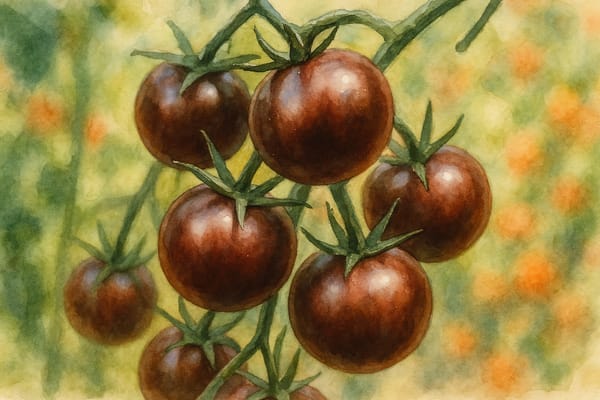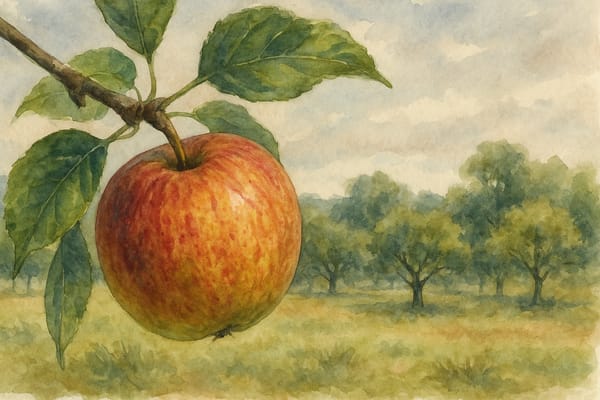In the late summer haze, when the garden is warm and whispering with bees, the black fruits begin to blush—first bronze, then deepening to a dusky, near-purple shine. Among the foliage, they appear like little gems threaded on green vines, glowing faintly in the light. These are Black Opal tomatoes: small, sweet, and full of shadowy promise. Grown well, they are one of the garden’s richest rewards.
But to reach this moment—when the fruits drop softly into your hand with a twist—takes a gardener’s attention, particularly in how the journey begins. Soil, warmth, structure, timing. Like many heirloom-style tomatoes, Black Opal is generous, but only if treated with care.
Sowing in Stillness: Preparing the Soil
To coax the first stirrings of life from a Black Opal seed, the compost must feel like home. Start with a fine, sterile seed-starting mix—something crumbly, with just a hint of nourishment. Avoid garden soil; it holds too many stories of past seasons, too many risks.
To this base, add 20–30% perlite or vermiculite—airy, white flecks that help roots breathe. If you're feeling generous, mix in some coconut coir to hold moisture and soften the texture, particularly if you’ll be slow to water. The aim is a damp sponge—not wet, not dry—perfectly balanced.
The ideal pH is neutral to slightly acidic (6.0–6.8), a gentle foundation for tomatoes to take up all they need. If you suspect yours is too sour or too alkaline, adjust with lime or ericaceous compost—but often, a good bagged seed mix does the trick.
Before sowing, moisten the compost fully, then fill your trays or modules. Tap to settle it—never press down—then sow the Black Opal seeds no more than 5mm deep. A dusting of vermiculite on top can help with warmth and consistency. Water from below, and wait.
The Warmth That Wakes
Tomatoes whisper to warmth. Black Opal needs steady temperatures of 18–21°C to germinate—think airing cupboard, heat mat, or a bright windowsill in spring. Too cold, and they sulk. Too hot, and they stall. Aim for calm, even heat. When the first shoots appear—between 7 and 21 days—begin to ventilate gently.
Uniform germination isn’t just tidy—it makes for manageable, even seedlings that grow without competing. It's the quiet start to a successful crop.
A Ladder to the Light: Growing and Supporting
Black Opal is a cordon tomato, an indeterminate type. Left to its own devices, it will sprawl like an overexcited vine. But trained—gently tied to a tall cane or twisted up string—it climbs. Outdoors or under glass, give each plant a strong, vertical support at least 2m tall.
Remove side shoots regularly to focus energy into one main stem, and as it grows, tie it in every 20–30cm. Use soft twine, and always leave room for the stem to swell.
Spacing matters—at least 40cm between plants, or two to three in a growbag. Too close, and they’ll trap humidity. Too far, and you waste light. The sweet spot allows air to move, sun to reach the lower leaves, and rain to dry before mildew arrives.
As trusses form, some may need extra support—a loop of twine under heavy clusters will do. And when five or six trusses have set, pinch out the top to stop more forming, and let the energy flow downward into ripening.
The Moment to Pick
You’ll know they’re ready by the colour. Deep red-black, glossy, and complete. No green shoulders. No streaks. A ripe Black Opal yields softly to touch—firm but not hard—and separates from the vine with a gentle twist.
Taste is richest when they’ve ripened fully on the plant. In the height of summer, check daily. Harvest in the morning for best texture. If the weather turns damp or chilly late in the season, pick those nearly ripe and let them colour indoors in a warm, bright spot.
For the Small Garden or Balcony
You don’t need a big garden to enjoy Black Opal. In fact, these are some of the best tomatoes for compact spaces. Grown upright in deep containers or tiered growbags, they thrive with good sun, airflow, and feeding. Train vertically, prune diligently, and harvest often.
Mulch to retain moisture. Feed with high-potassium tomato food once the first trusses appear. And never let them dry out completely—this causes split skins and bitter fruit.
Companion planting—such as basil, chives, or marigold—can boost health and beauty alike, turning even the smallest patio into a productive, aromatic patch.
The Gift of Dark Fruit
What makes Black Opal special is more than flavour—though its sweetness and tang are excellent. It’s the depth of colour, the way it feels old and new at once, the way it brightens a plate without ever seeming flashy.
In a Cornish garden, especially one kissed by the coast or warmed in a courtyard, these dark jewels thrive. They remind us that gardening is not only about produce—it’s about tending the conditions in which something exquisite can appear.











